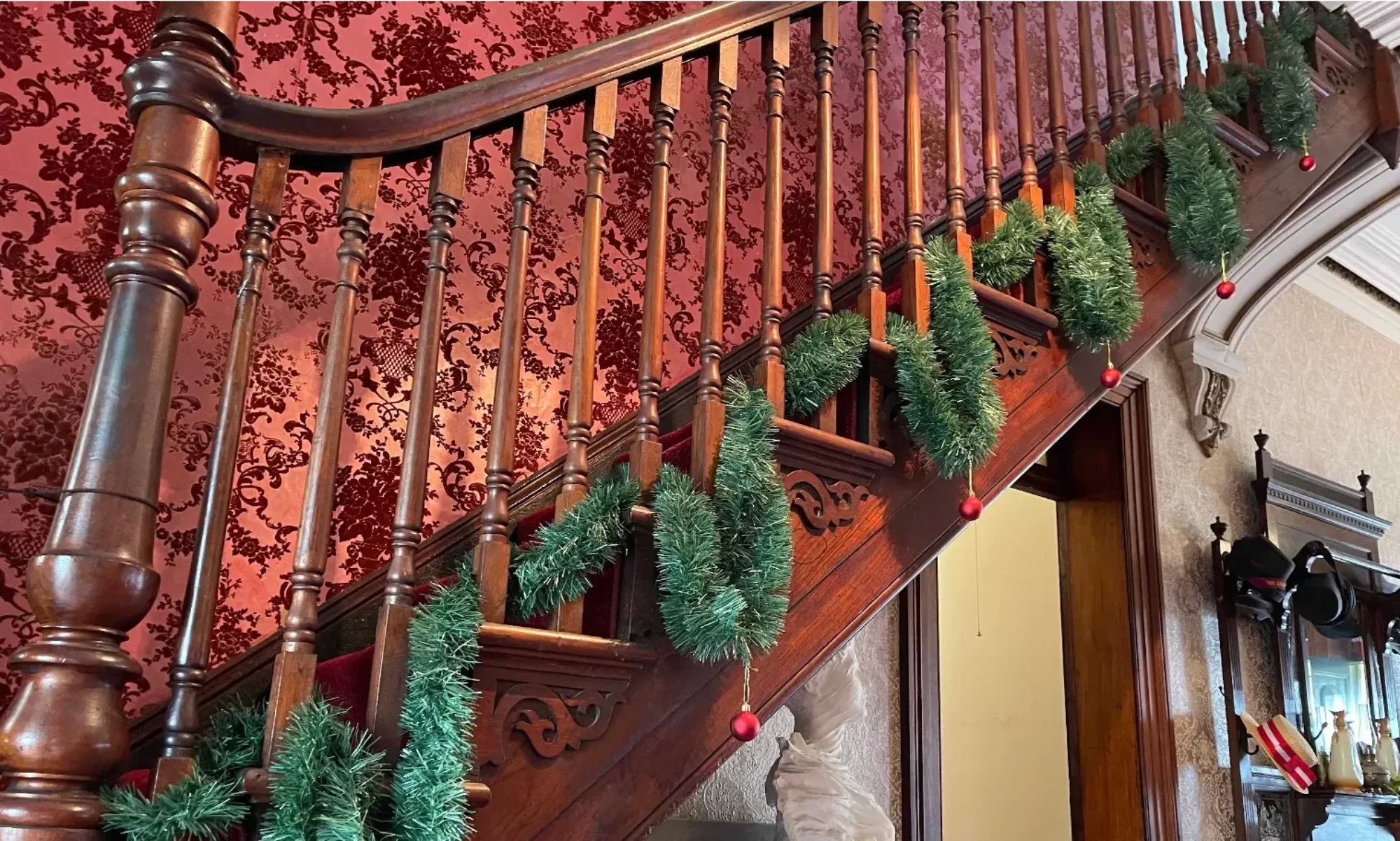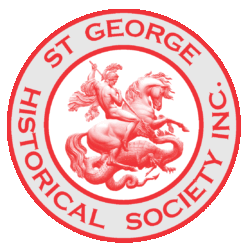by Gifford Eardley
Without a doubt one of the most attractive places for small boys in old time Rockdale was the blacksmith shop of Duncan Roy, whose premises were sited on the northern side of the Town Hall. Standing at the wide doorway facing Rocky Point Road children gazed in awe at the shower of sparks rising from the red-hot iron as it was hammered upon the anvil when making horseshoes and other implements then in common demand. There was a charming atmosphere about the interior of the roughly built premises, the acrid smoke from the fire, the wheeze of the hand operated bellows, the restlessness of the horses who, tinged with fear, were waiting to be shod, the murky sunlight filtering into the gloom through the rear windows, and the leather-aproned blacksmith in person, a mighty man was he. One is filled with nostalgia for this era which has almost disappeared into the limbo of forgotten things, as today there are very few practising blacksmiths, and those who remain are inundated with business. Sadly enough there are few, if any, of the younger generation desirous of learning the skills associated with the blacksmith’s trade.
Relying on the memory of certain members of our St. George Historical Society it may be stated that the forge building, constructed of yellow painted weatherboard, was set back a little distance from the footpath alignment. Its front and rear doorways were of the double door type and of sufficient width to permit the entry of horse drawn vehicles in need of repair. There were two forges in use, both being arranged on the southern side of the low roofed building, and voiding much of their smoke through brick built chimneys which projected well above the roof line Another fire could be arranged in circular fashion in the back yard where cart tyres were heated preparatory to being dropped over the wooden wheel assembly. They were then shrunk into position per medium of buckets of water, thus holding the wheel components together in a tenacious grip. It was a most interesting process, and one which called for a great deal of practical knowledge and skill. It is understood that the iron tyre was curved to form a diameter of two inches less than that of the wooden wheel, the tyre, when heated, expanding to a greater diameter than the wheel at the rate of about three-sixteenths of an inch per foot of diameter.

Duncan Roy’s son, Horace, helped his father in the blacksmithing business and was also an accomplished farrier and wheelwright. All manner of horses, from stalwart draught horses to ponies, came to be fitted with shoes and, in the bleak days of winter their waiting owners indulged in local gossip ranged around the warmth of the forge fire, keeping discreetly out of the way of the busy blacksmith, or giving a hand at the wheezing bellows. The average life of the horse shoes was about three weeks, owing to the rough sandstone surface of the streets, together with the continual stamping of the animals brought about by the unremitting attentions of house flies. The horses could only kick backwards and once the smithy had one of the animal’s legs off the ground he was comparatively safe. The cost of a set of shoes was in the vicinity of five shillings.
At the risk of being thought technical one feels that a short description of the tools, and methods of using same, would not go amiss from a purely historical angle. This data was supplied in detail by Mr. W. Manning, of Hector Street, Sefton, who was a craftsman of no mean order and one that specialised in the shoeing of race-horses.

FLOOR TOOLS
“Shoeing Hammer”. Usually self forged. Made like a claw hammer, the claw being used to cut the ends of the nails off after hammering into the hoof, “RASP”. This was a combination tool with a rough toothed rasp on one side and a file on the other. It was used for levelling the hooves. “CUTTING KNIFE AND TOE KNIFE”. This instrument was shaped like a small tomahawk with a slightly dished blade. “BUFFER”. Used to cut existing nails in the hooves prior to the removal of the old shoes.
The shoeing nails, of “T” brand, were purchased ready made. They were driven for a distance of approximately two inches into the hoof and brought down outside of the hoof where the ends were bent and cut off with the shoeing hammer.
FORGING TOOLS
Four pound turning hammer, fitted with a 14 inch handle, was used for shaping shoes on the anvil. The shoe-steel bars were supplied by Messrs. Friend and Company in a range of cross sections A “FULLER” was used to cut the sunken ridge-like depression around the shoe to house the nail heads. These were in at least two sizes, one for ponies and the other for- horses. A “HOLER” was used, fitted with a handle, for piercing holes in the shoe during the early process of manufacture, A “PRICTHEL”, an instrument generally forged from an old worn-out file, about ten inches in length, tapered down to a small square-shaped point. In use for driving through the heated shoe to give the required shape to the nail holes. Four nail holes were driven on the outside of the hoof and three on the inner side was the usual practice.
The front portion of the shoe was shaped to a tapered point, known as the “Big-clip”, which laid against the front of the hoof thereby taking away the road stress from the rest of the shoe. The rear of the shoe was, at times, doubled back on its self, this was known as a”Heel and Bar”. Another variation was to bend back the bar stock at the end of the shoe for a distance of about one and a quarter inches, which with the ‘Big Clip”, assisted in holding the shoe in place when fitted to draught animals.
The horse hoof is about a quarter of an inch in thickness and the sole averages half an inch. Great skill is need in driving the nail upwards into the hoof. A good farrier generally took about ten minutes to shoe four hoofs, although the job has been done in six minutes. The back feet were lifted to the hip to permit a shoe being fitted. Some animals were fractious during the process and care had to be taken against being kicked.
The farrier wore a leather apron split down the middle, and together with a boy who operated the forge bellows for blowing up the fire of slack coal, and also with the hammer striking at the anvil, could make and fit four shoes in about three quarters of an hour. The bellows, constructed of wood and leather, were locally made, but a steel fan type, hand turned through gears, were also in use at some forges. Most other metal work, apart from the manufacture of horse shoes, was generally in the nature of repairs to existing equipment. It was customary for the smith to make a spare set of shoes for his regular horse-owning customers, hanging them on the wall until time as they were needed.
Duncan Roy manufactured such ironwork needed for the construction of horse-drawn vehicles built by the neighbouring firm of Messrs. Welch and Walker, who were wheelwrights and wagon and sulky body builders of repute. Their premises were located on Rocky Point Road about two doors south of Mr. Iliffe’s “Rose Vale” Villa.
There was another blacksmithing establishment at Rockdale, that of Arthur Nicholson, who lived at Jewfish Point, west of Oatley. His premises were largely built of upright wooden slabs, enclosed by an iron roof, the building abutting onto the footpath south of, and in the immediate vicinity of the Royal Hotel. He usually had in his employ two or three Irish boy immigrants, thus giving them a start in life and a chance to learn a specialised trade. Arthur Nicholson was responsible for the shoeing of many of the racehorses kept in the East Kogarah area. However, with the closure of the Moorefield Racecourse and the abandonment of the various local stables nearby, together with the universal adoption of motor transport, the smithies both at Rockdale and Kogarah closed down for the want of business.
This article was first published in the August 1970 edition of our magazine.
Browse the magazine archive.

